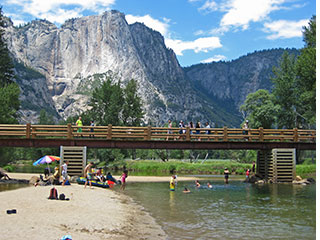Along with her parents and seven-year-old sister, the six-year-old subject was wading in a shallow area of the river, just below Swinging Bridge. The subject’s parents don’t know how it happened, but all of a sudden they saw the subject slipping below the water in what turned out to be a deep section of the river; the last they saw of their daughter was one of her hands reaching skyward before it disappeared. The mother and then the father, both fully clothed, jumped into the water at the spot they last saw their daughter. Neither parent knows how to swim, so they also sank to the bottom of the river. A bystander, watching what had just happened, jumped off the bridge into the river, and with one arm grabbed the six-year-old subject, while with the other arm he pushed the father, who in turn pushed against the mother, up and out of the water. Other bystanders helped the parents out of the water, while the original bystander carried the subject out of the water. The subject never lost consciousness and reported to clinic staff that she remembered the entire episode. The parents estimate she was submerged under the water for 1-2 minutes. After she was rescued, the subject was coughing persistently, but was able to breathe on her own.
 About an hour after the near-drowning episode, the subject complained of a stomach ache and vomited multiple times; her parents brought her to the clinic for further evaluation. After consulting with Children’s Hospital Central California, the clinicians at the Yosemite Medical Clinic advised the subject’s parents to have her transported by ambulance to Children’s Hospital for more extensive evaluation and overnight observation.
About an hour after the near-drowning episode, the subject complained of a stomach ache and vomited multiple times; her parents brought her to the clinic for further evaluation. After consulting with Children’s Hospital Central California, the clinicians at the Yosemite Medical Clinic advised the subject’s parents to have her transported by ambulance to Children’s Hospital for more extensive evaluation and overnight observation.Submersion injuries can present in a variety of ways. The victim can be completely unresponsive and pulseless or can be awake and oriented and seemingly unscathed. It is worth noting that even subjects without any symptoms that suffer near drowning can still decompensate into respiratory failure up to 8 hours after the injury. It is therefore essential that all near-drowning victims receive further medical assessment.
It is imperative for those playing in and near water in Yosemite to understand that drowning incidents occur not only in fast moving white water, but also in shallow, slow, seemingly benign bodies of water as well. This is particularly true for young children and those who do not know how to swim. According to the Centers for Disease Control (CDC), every day in the United States, ten people die from unintentional drowning. Of these ten, two are aged 14 and younger. Children ages 1 to 4 have the highest drowning rates. Research has shown that both lack of swimming ability and lack of close supervision influence drowning risk.
One drowning prevention strategy that is particularly important in Yosemite is close supervision of children when they are in and around rivers and lakes. The CDC recommends that “because drowning occurs quickly and quietly, adults should not be involved in any other distracting activity...while supervising children…” It is worth noting that the adult responsible for the supervision of the child should be comfortable and capable of swimming him or herself. The supervisors of young children should provide “touch supervision,” close enough to touch or reach the child at all times.
Learning to swim is another drowning prevention strategy that is important for both children and adults. If you are planning to vacation in an area with pools, lakes, rivers, or ocean, please consider enrolling you and/or your child in beginner’s swimming lessons. Most local pools, YMCAs, and American Red Cross chapters offer local swimming, first aid, and CPR classes. Visit your city or town’s official website to find out where you can participate in swimming lessons in your area. It could save a life!
For more information on unintentional drownings, please read the Center for Disease Control’s water injuries fact sheet.
